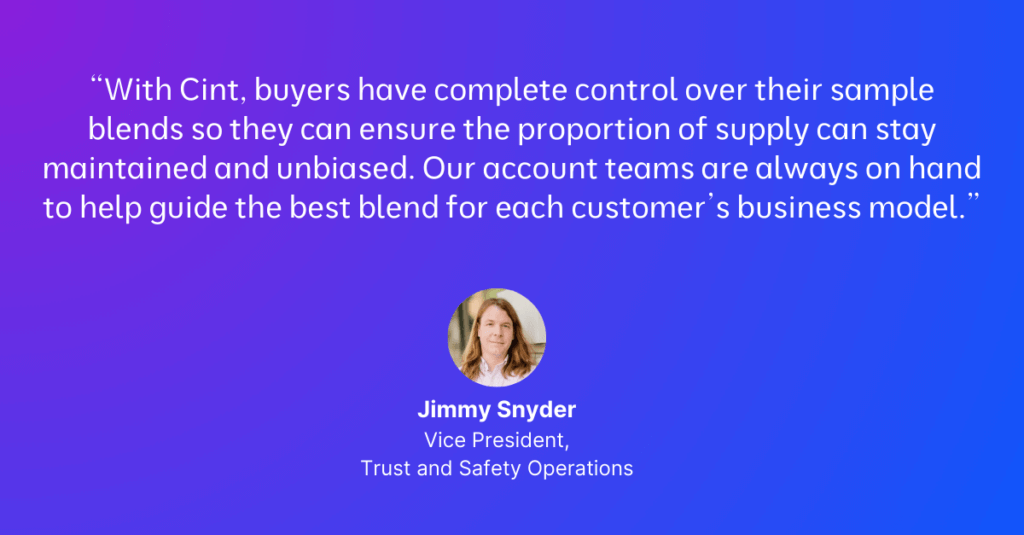Introduction
Programmatic research is the automated buying and selling of responses to surveys in a marketplace environment. In systems of this kind, transactions occur automatically, with minimal human intervention.
By replacing the traditional manual sampling process—which often relied on spreadsheets and emails—programmatic sampling offers significant benefits. Companies can achieve large-scale efficiencies, including lower costs, reduced error rates, increased mitigation against fraud, and easy access to a global respondent pool.
This all sounds great, but how can research and insights professionals ensure that good-quality responses and programmatic research really go hand in hand?
Want to know more about the importance of maintaining quality in programmatic research for buyers? Jimmy Snyder, Vice President of Trust and Safety, and Shelby Downes, Senior Program Manager were on hand to run us through how best to maintain high quality in an ever-changing landscape.
Advanced solutions for accurate insights
Buyers looking into programmatic research often worry about the authenticity of their data and whether the survey responses they receive are real and reliable for generating insights.
“Fraud has grown significantly in the last five years,” Snyder says. “We have seen organized fraud groups grow, coordinate, and attack our industry at an alarming rate.”

One of the major steps that Cint has taken to tackle fraud and ensure data quality and accuracy is the introduction of the Trust Score model. The centerpiece of our global data quality commitment to deliver authentic insights from real people, Trust Score predicts fraud before it happens. Its machine-learning model intelligently evaluates participant behavior to eliminate poor quality data that could hinder good quality consumer insights.
Each time a participant enters the survey workflow, Cint Trust Score evaluates their previous activity against our massive data pool to grade their authenticity based on a variety of predetermined criteria.
To put it simply, we’re fighting bots with bots.
In addition to the Trust Score, Cint offers automated fielding capabilities through the Cint Exchange — the world’s largest research marketplace — that can mitigate fraud through AI-assisted balancing of quotas.
There’s also the matter of sample blends. Sample blends involve controlling which panels contribute respondents to a project. This helps to ensure the representation of the sample over time and avoid bias by having certain panel(s) provide the majority of sample.


“With Cint, buyers have complete control over their sample blends so they can ensure the proportion of supply can stay maintained and unbiased,” says Jimmy Snyder. “Our account teams are always on hand to help guide the best blend for each customer’s business model.”
Automated fielding also plays a role. “Fraudsters commonly use velocity attacks where they will target surveys and flood them with bad completes,” says Shelby Downes. “Automated Fielding allows clients to control the rate at which sample flows into their projects. This means that it’s harder for fraudsters to fill all quotas before clients have a chance to check their data and raise the alarm.”
Cutting costs and saving time
Traditional research methods can be costly — both fiscally and in terms of the time they take up. Enabling a programmatic approach can save time and money.
When data quality is low, buyers may fail to meet their quotas and have to redo surveys. Customers on the supply side are impacted too with reversals causing cost-related headaches.
Clients are also facing higher costs due to the need for enhanced anti-fraud solutions. As budgetary restraints remain a concern for market research and insights professionals, how can quality be squared with cost?
“Researchers can simply set their project up and leave it to run whilst they work on other priorities,” says Shelby Downes. “Cint’s suite of quality checks automatically checks sample as it flows into the project. We will even send automated alerts to researchers if there are errors restricting sample.”
For many customers on the buyer side of market research, time is often as tight as money. There’s always the worry that delay in drawing research conclusions is possible, and in the worst scenario, poor-quality data could even end up costing them valuable clients.
“Researchers don’t have to spend time hunting down the right candidates as programmatic research connects them with a global pool of pre-profiled respondents waiting to take a researcher’s survey,” says Downes.
“Clients set up quotas to ensure balanced representation within surveys,” continues Downes. “But Cint saves clients time by offering templates. Researchers can choose from Cint designed templates or create their own templates.”
Cint is investing heavily in our technological and operational quality solutions, as well as providing clients with more ways to automate project management, cutting down on the time spent on surveys.
Never ignore the human element
Despite the incredibly important role that advanced technological solutions play in ensuring quality and programmatic research, actual people still play a huge role in shaping quality in research.


To that end, Cint deploys our humans through our operational programs. This allows us to implement measures and processes that catch what automated technology is missing. In turn, this provides Cint with a human-centered framework that allows us to innovate our products and enhance the protection we offer on the Cint Exchange.
“Cint’s operational programs are designed to manage and maintain quality across all of our quality pillars; buyer, supplier, respondent, product, service/operational,” says Downes.
For example, we have systems in place which flag abnormal reconciliations. These could occur due to buyer-related errors such as rejecting all completes. Our technology automatically turns those reversals back into completes, alerting the buyer who can then assess and reconcile correctly. If additional support is needed, our humans are on hand to help.
As Downes puts it, “Humans work in tandem with technology to ensure the best possible results.”
Conclusion
Technology alone cannot guarantee flawless data quality. The human element remains crucial in ensuring that quality control measures are comprehensive and effective.
At Cint, technology and humans work in tandem to deliver the most accurate and reliable insights, allowing researchers to overcome the challenges of programmatic research while still reaping its benefits.
Want to talk about programmatic research? Join the conversation on our LinkedIn page.
